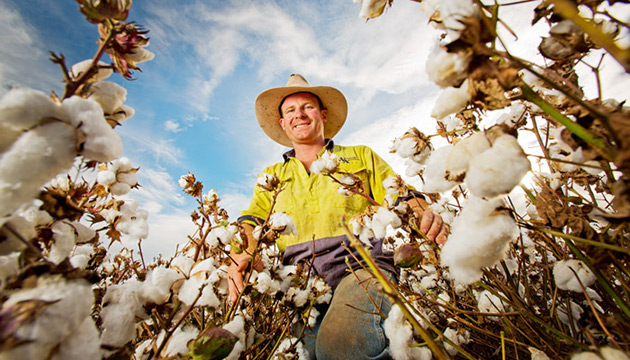Reliable water, new varieties and strong prices are driving cotton expansion into the Murrumbidgee Irrigation Area.
Story By Nathan Dyer
As a giant green spray rig roars past his office, George Commins has his eyes glued to a computer. The GPS program on screen is tracking a cotton picker 20 kilometres away and feeding real-time harvest data to the 27-year-old’s desktop at Whitton, 25km west of Leeton, in New South Wales’ lush Murrumbidgee Valley. Beyond the walls of the office, a sea of white cotton plants awaits the harvester’s comb.
“As a new industry, it’s probably the most exciting thing in agriculture in the area at the moment, and it’s great to be part of it,” says George, monitoring progress of the first Commins paddock to be harvested this season. It’s four bales so far and more than 15,000 to go as the pickers make their way over 1500 hectares of irrigated cotton on the family property. “The best thing about cotton is that you’re in an international market, so you’re not competing against your neighbours for markets,” George says. “Because of that, information is shared freely, and it’s in everyone’s interest to produce high-yielding, high-quality cotton.”
With 36,000ha of the fibre crop planted in the Murrumbidgee Irrigation Area (MIA) this season, George is in good company. Over the past four years, the 660,000ha Riverina scheme – 23 percent of which is planted to irrigated crops – has seen a boom in cotton plantings driven by reliable water and new, genetically modified varieties suited to the shorter southern growing season. The area planted has doubled from 18,000ha in 2011. And as drought continues to drain water reserves in traditional cotton-growing regions further north, around the towns of Narrabri and Moree in New South Wales and Goondiwindi and St George in Queensland, growers in the MIA will this year produce about a quarter of Australia’s estimated 1.9 million-bale crop. Although the area planted nationally is down 53% year-on-year, cotton plantings in the MIA have increased 12%. This year’s crop – most of which is destined for Chinese cotton mills – is expected to return more than $200 million to Riverina growers. With prices of more than $500 per bale locked in for the next three years on global futures markets, cottonseed selling for around $350 per tonne and high-security water allocations at 95% in the snow-fed Murrumbidgee system, optimism is high.
This Story is from Issue #102
Outback Magazine: Aug/Sept 2015










